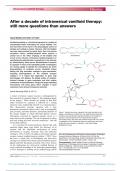Intravesical vanilloid therapy
Review
After a decade of intravesical vanilloid therapy:
still more questions than answers
Arpad Szallasi and Clare J Fowler
Vanilloid sensitivity is a functional signature of a subset of
O
unmyelinated fibres innervating the urinary bladder. The
role that these nerves have in the physiological control of OH
storage and voiding is unclear. However, after the bladder N
has been disconnected by spinal injury from the pontine H
micturition centre, vanilloid-sensitive fibres assume a
central role in the reflex emptying of the bladder that Anandamide
occurs at low volumes. Intravesical vanilloid (capsaicin or
resiniferatoxin) administration is beneficial in this disorder
by “desensitising” these nerves. Resiniferatoxin is superior
to capsaicin in terms of its tolerability profile. Investigators N OH
are moving rapidly to identify the mechanisms by which H
Capsaicin
desensitisation to vanilloids occurs. Vanilloids induce
lasting, but fully reversible, changes in gene expression, OCH3
including downregulation of the vanilloid receptor
subtype 1. It is hoped that application of gene chip
technologies will address the global profile of vanilloid-
induced changes in gene expression and their relative
contribution to desensitisation. Drugs that target signalling
mechanisms that bring about these changes in gene O
expression have obvious therapeutic potential. O O
H
Lancet Neurology 2002; 1: 167–72
A subset of primary sensory neurons is distinguished by
their sensitivity to capsaicin (figure 1), the pungent principle O
OH OCH3
in hot pepper.1,2 These neurons are unique in that their
O
initial excitation by capsaicin is followed by a lasting O
refractory state, traditionally referred to as desensitisation.1 Resiniferatoxin
This characteristic provides capsaicin with a clear OH
therapeutic potential in disease states, such as neuropathic
pain, pruritus, and other disorders, particularly disorders of Figure 1. Vanilloid structures: capsaicin, the irritant principle in hot
the urinary bladder in which abnormal afferent sensory pepper; resiniferatoxin, isolated from the medicinal plant Euphorbia
information conveyed by capsaicin-sensitive nerves is a resinifera; and anandamide, originally identified as an endogenous
major factor in the aetiology.3 The use of capsaicin to relieve activator (“endocannabinoid”) of cannabinoid CB1 receptors.
The vanillyl moiety, after which the vanilloid receptor VR1 was named,
pain and itching has been reviewed extensively3–5 and will is highlighted in red. Anandamide lacks the vanillyl group but shows
not be dealt with here. limited structural similarity to capsaicin in the amide linkage
As is common for natural products, clinical trials with (highlighted in blue).
capsaicin began many years before the discovery of its
receptor and the subcellular mechanisms of action
downstream to receptor activation. Since the molecular
cloning in 1997 of cDNA encoding a functional capsaicin AS is at the Department of Pathology and Immunology, Washington
receptor, termed vanilloid-receptor subtype 1 (VR1),6 there University School of Medicine, St Louis, USA. CJF is at the
has been a steady flow of bewildering new discoveries Department of Uro-Neurology, National Hospital for Neurology and
causing us to rethink what is known about vanilloid receptor Neurosurgery, University College London, London, UK
ligands and their therapeutic potential. This review focuses Correspondence: Arpad Szallasi, Division of Clinical Pathology,
Department of Pathology and Immunology, Washington University
on the implications for intravesical vanilloid therapy of School of Medicine, 1 Barnes Plaza, St Louis, MO 63110, USA.
newly acquired knowledge of the molecular pharmacology Tel +1 314 836 5467; fax +1 314 362 8950;
of VR1. Attempts to develop novel vanilloid drugs will be email aszallasi@path.wustl.edu.
THE LANCET Neurology Vol 1 July 2002 http://neurology.thelancet.com 167
For personal use. Only reproduce with permission from The Lancet Publishing Group.
, Review Intravesical vanilloid therapy
summarised. For readers interested in a detailed overview of VR1, and there may be a third, as yet unidentified, arvanil-
the clinical trials with intravesical capsaicin and sensitive target.23 This discovery seems to be a promising
resiniferatoxin, references are provided.7–11 new lead for drug development.
There is preliminary evidence that a cannabis-
Vanilloid-receptor ligands based medicinal extract containing both
Target for pungent natural products (-)-⌬9-tetrahydrocannibinol and cannabidiol may prove to
Specific binding of resiniferatoxin (figure 1), an ultrapotent be an effective treatment for refractory urinary
capsaicin analogue isolated from the cactus-like plant symptoms in patients with advanced multiple sclerosis.24
Euphorbia resinifera,12 provided the first proof for the Tetrahydrocannibinol is a potent CB1 receptor agonist with
existence of a specific membrane recognition site for no activity at the VR1 receptor. Conversely, cannabidiol is
capsaicin.1–3 Since capsaicin and resiniferatoxin share a an agonist of human VR1 but is inactive at CB1 receptors.25 If
vanillyl moiety essential for bioactivity (compare structures cannabidiol really does provide the cannabis extract with an
in figure 1), but differ greatly in the rest of the molecule, this added therapeutic benefit, this lends experimental support
membrane recognition site was named the vanilloid to the concept of shared agonists of VR1 and CB1, such as
receptor.1–3 The term is something of a misnomer because it arvanil, being clinically useful drugs.
also recognises compounds that lack any identifiable
vanillyl-like motif. Such novel “vanilloids” include Structure and function of VR1
unsaturated dialdehydes, such as isovelleral, isolated from Molecular pharmacology
the hot mushroom Lactarius vellereus, and the triprenyl VR1 is a serpentine membrane protein with six complete
phenol, scutigeral, which is present in the edible mushroom (S1 to S6) and one partial (linking S5 to S6) transmembrane
Albatrellus ovinus.13 spanning segments and a predicted molecular mass of
95 kDa.6,26 VR1 functions as a non-selective cation channel
Factors hindering the clinical use of vanilloids with the pore localised to the partial transmembrane region,
The most important limiting factor of the clinical use of also known as the P-loop (figure 2).27 VR1 is one of the
capsaicin is its pungency.3 Despite in-depth study into the transient-release-potential (TRP) family of store-operated
relations between structure and activity of capsaicin calcium channels.6 To reflect this relationship it has been
analogues, no better drug candidate has been discovered to suggested that VR1 be renamed TRPV1;28 it remains to be
date. One of the most promising is olvanil, which is less seen whether this new nomenclature gains broad acceptance.
pungent and can also be given orally.14 Resiniferatoxin is also The recently cloned human VR1 shows 92% homology with
substantially less pungent than capsaicin in doses at which it rat VR129 and has a chromosomal location of 17p13,30
induces a lasting desensitisation of the bladder afferents.15 downstream of the nephropathic cystinosis gene. VR1 seems
Attempts at therapy with resiniferatoxin have been plagued not to be a specific vanilloid receptor but acts as a shared
with problems, particularly because the molecule is highly sensor for various noxious stimuli, including high
lipophilic and thus difficult to keep in aqueous solution.16 temperatures (>40°C) and acidic conditions (pH<6).31 The
There is also good evidence that resiniferatoxin binds to term vanilloid receptor should, however, be retained to
plastics.16 Furthermore, once dissolved, it may have a very distinguish VR1 clearly from other heat and proton sensors
short shelf life. These factors have hindered attempts to present on unmyelinated fibres. Site-directed mutagenesis
demonstrate the efficacy of intravesical resiniferatoxin.
Additional research will overcome these problems.
P-loop
Furthermore, we understand that several pharmaceutical
636 646 648 651
companies have programmes to develop simplified VR1
ligands (Krause JE, personal communication). SA C K P G NSY NSL Y ST C L E L F K F T I G M G DL E F T E N Y
The endocannabinoid anandamide as an
“endovanilloid”
Anandamide (figure 1) and related lipid mediators are the
most controversial of the newly discovered vanilloids.17
Anandamide is better known as an endocannabinoid,
preferentially acting on cannabinoid CB1 receptors.18 In the
peripheral nervous system, CB1 is coexpressed with VR1 on
a subset of unmyelinated fibres.19 Arguments for and C
against anandamide being an “endovanilloid” have been
presented,17,20,21 but unequivocal evidence is still lacking.
Either way, hybrid ligands like arvanil, 17,22 which combine N
structural features of vanilloids and cannabinoids
(compare structures in figure 1), may increase their Figure 2. The predicted membrane topology of the vanilloid (capsaicin)
receptor subtype 1 (VR1) with the P-loop highlighted. The P-loop is
therapeutic effects by targeting two separate receptors on believed to contain the channel pore, as well as the proton sensor.
the same nerve ending. Arvanil is far more potent in some Reprinted with the permission of The American Society for Biochemistry
bioassays than expected from its affiliation for CB1 and and Molecular Biology.27
168 THE LANCET Neurology Vol 1 July 2002 http://neurology.thelancet.com
For personal use. Only reproduce with permission from The Lancet Publishing Group.





